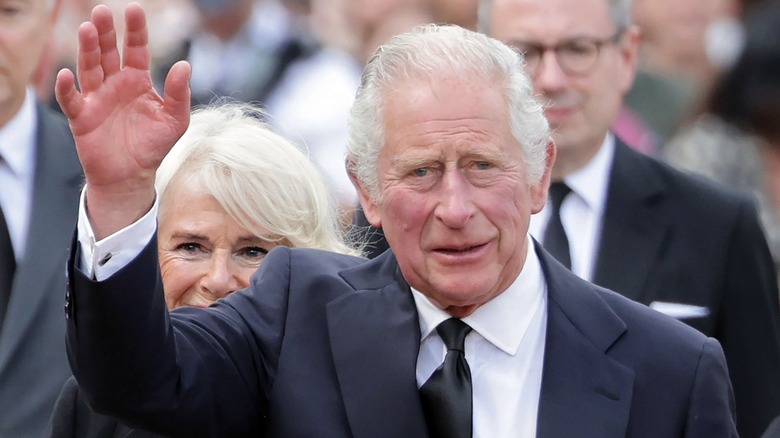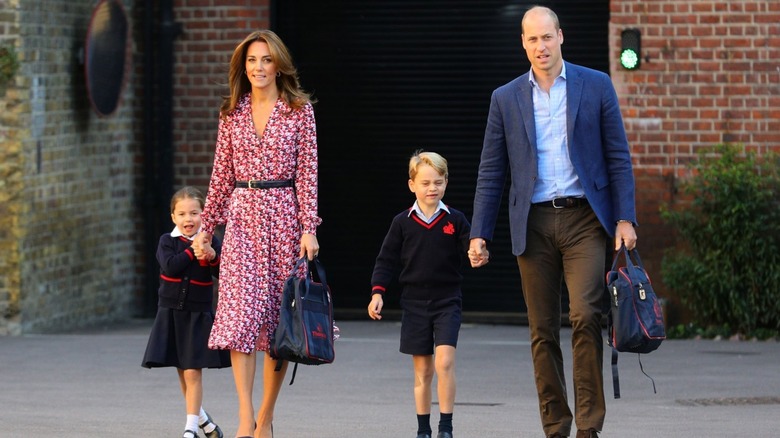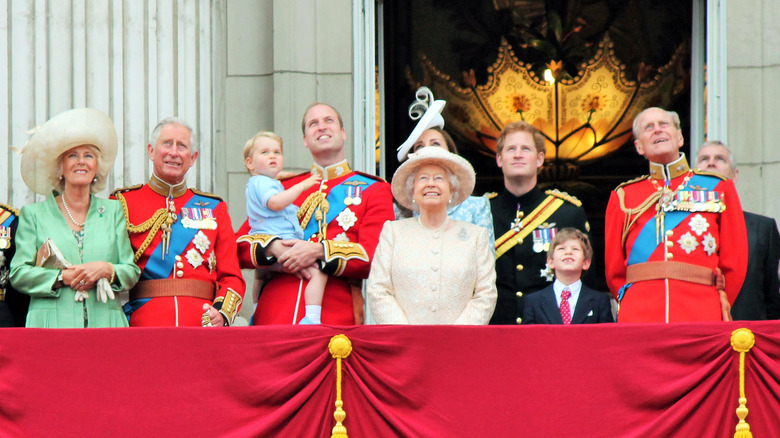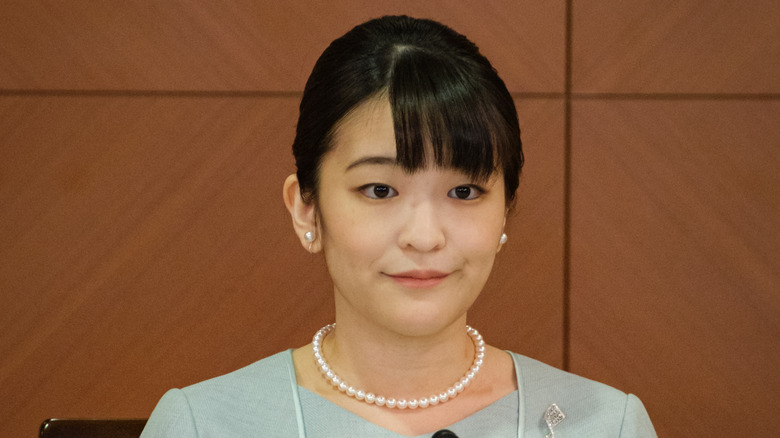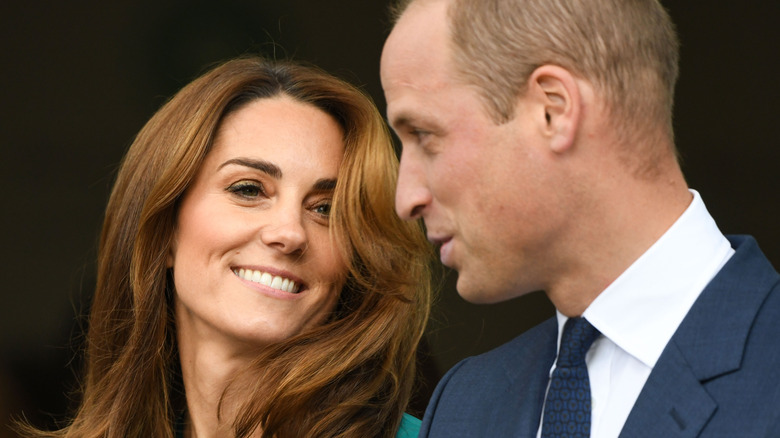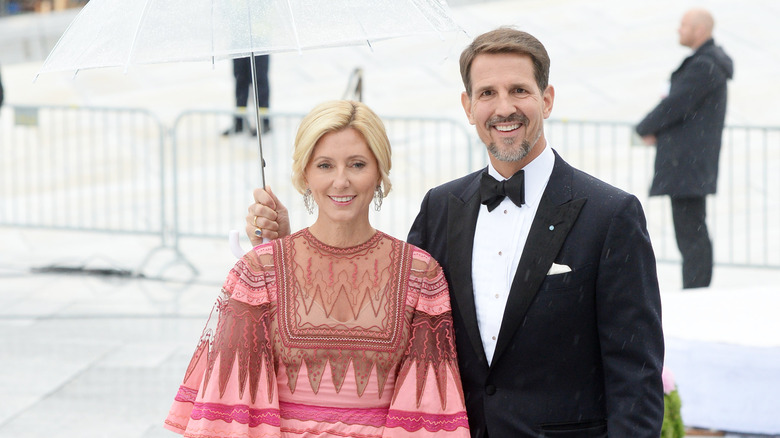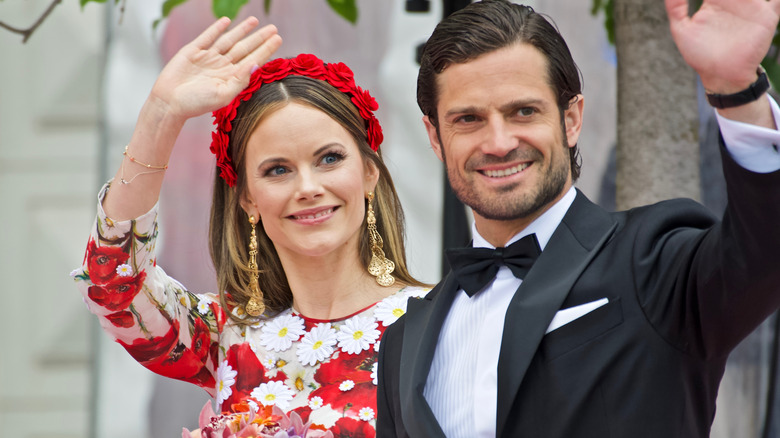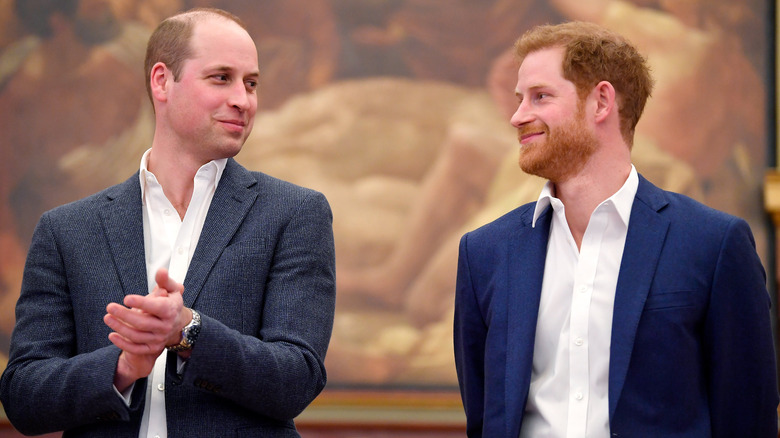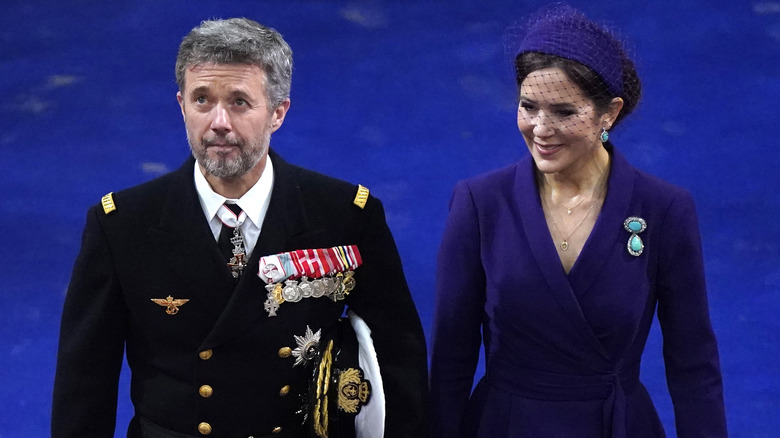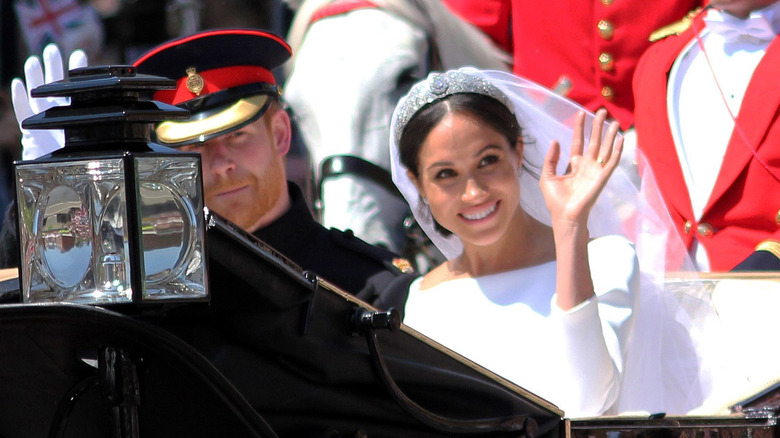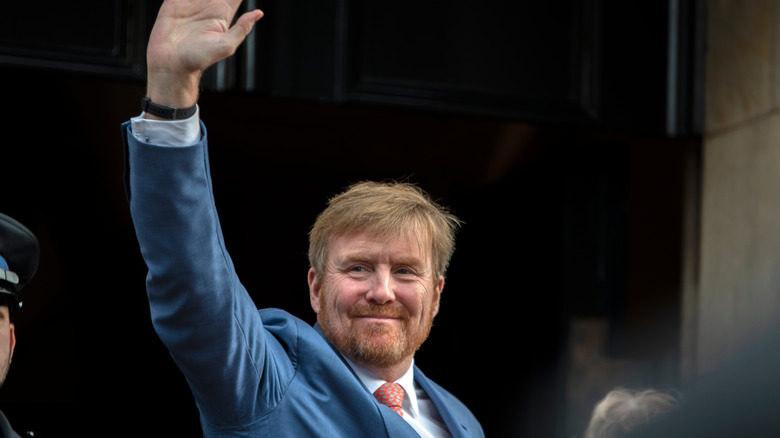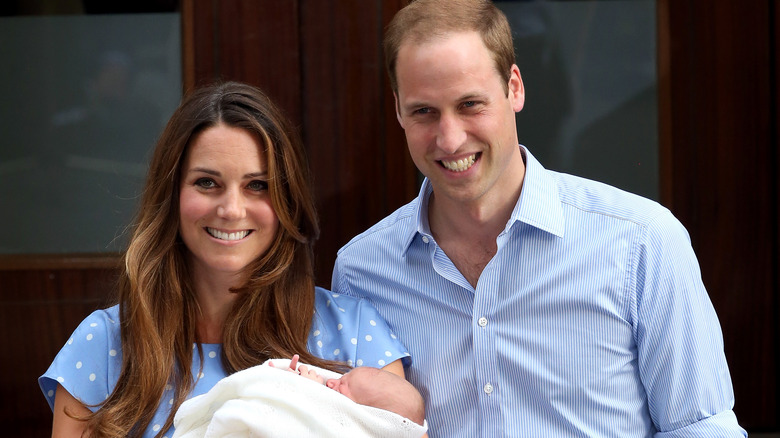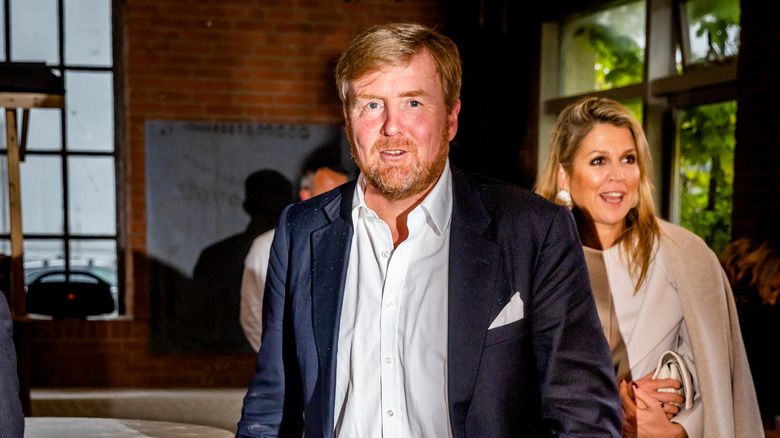Strict Rules Royals From Around The World Have To Follow
There are tons of perks that come with being a royal, like living in a palace, access to incredible clothes and jewels, and seemingly unlimited funds. But with those perks come rules, some of which make sense given their position in their countries, but others that might not be worth all the luxury and riches. And these rules aren't just for those born with a title — they extend to those within the royals' inner circles, as well as the public in some cases.
We're well aware that the British royals have lots of rules by which they have to abide, particularly the women as they're subject to certain beauty standards in addition to those regarding their behavior. But the heirs to the throne in Britain aren't the only royals around the world that have strict rules to follow. Royal families from all across the globe are forced to abide by certain customs and regulations. Here are some strict rules we commoners don't have to follow.
British royals can't be touched
If you were thinking about touching a British royal, think again. There's a strict no-touching policy in place for the public regarding members of the royal family. When Prince Harry and Meghan Markle were expecting their first child, royal expert Grant Harrold shared expectations the public should have had surrounding the baby's birth. As he told Insider, "Royal babies should be looked at, but never touched. The public must be respectful." Harrold also mentioned that the child would be christened with water from the same river in which Jesus was baptized and that the child would have anywhere from five to seven godparents.
There's a lot to be mindful of when it comes to a royal baby, but they aren't the only members of the royal family with strict protocol. As for being touched, no members of the royal family are allowed to be touched by members of the public. As Harrold said, "As well as an etiquette rule, it poses a major security risk if someone is able to get so close that they are able to touch members of the royal family." If you want to shake hands with a British royal, you might be considered a threat.
British heirs can't fly together
When most people take family trips, they drive in the same car or fly on the same plane, but most people aren't royals. When members of the British royal family travel together, certain members have to be on separate aircraft. Those certain members? Heirs. The logic behind the rule is that if one plane goes down, there will be another one safely carrying an heir to the throne. The rule is more of a guideline, though, and whoever is at the top — King Charles as it now stands — can let heirs travel together if he so chooses.
This unofficial rule has been in effect for many years, and it explains why King Charles and Prince William don't travel together. But this rule goes beyond adults. Prince William and Prince George will no longer be able to travel together when Prince George turns 12, though some royal experts have reported that William and Kate haven't been following orders for years and should have had Prince George travel separately long ago. There was even chatter when Prince Harry and Meghan Markle gave birth to their first child that they wouldn't be able to fly together due to the rule, but since they've given up their royal status, the rule no longer applies.
Japanese princesses have to marry other royals
Many rules that royals have to follow seem silly, but others seem downright archaic in modern times. In Japan, if a member of the royal family marries a commoner, that person loses their royal status. This phenomenon has only occurred twice, and both times happened to have been in the past two decades: once in 2005 and again in 2017. In 2005, Princess Sayako gave up her royal status to marry a commoner, and in 2017, Princess Mako did the same. For Princess Mako, the wedding was postponed for several years due to legal and financial issues.
After years of trying to sort out said issues, Princess Mako was able to marry her husband Komuro Kei in 2021. The couple didn't stay in Japan too long after their nuptials, though, and they moved to New York City where Princess Mako began volunteering for the Metropolitan Museum of Art. Upon moving across the world, Princess Mako, who has multiple degrees in art studies, said, "What I would like is just to lead a peaceful life in my new environment," as reported by the Japan Times.
British royals must ask for permission to get married
Of all the rules royals have to follow, having to ask permission to get married seems like the most innocuous given the tradition most people follow of asking their partner's father for their hand in marriage. For commoners, though, it's simply a tradition. For British royals, it's codified law. British royals in line for the throne have to ask the King or the Queen for permission to get married. For then-Prince Charles, Prince William, and Prince Harry, this meant asking Queen Elizabeth (though Prince Harry claimed in his memoir that his brother did not need to ask permission to ask Kate Middleton to marry him). For future royals, it'll either be King Charles or Prince William when he becomes King.
And despite all the drama that's occurred in the past several years with Prince Harry and Meghan Markle, Prince Harry and his children are still technically in line for the throne. Because of this, when his children, Archie and Lilibet, want to get married, per British law they may have to ask permission. This could change, though, as the law states that only the first six in line for the throne have to ask permission. If Prince William and Kate have more children, or if their children have children, Archie and Lilibet will move down in the line of succession. If they're not sixth or higher in line, the rule will not apply.
Greek heirs still receive titles despite their monarchy no longer existing
The 20th century brought about an end to several royal institutions, including the Greek monarchy. The Greek monarchy was officially abolished in 1974, and its heirs were exiled. Despite this royal drama, the members of the Greek royal family still have nominal titles. And though they have no legal jurisdiction, the Greek royal family still takes their titles seriously. As Pavlos, Crown Prince of Greece said to Point de Vue magazine (via Yahoo), "I inherited this role from my father, not associated with any responsibility at the state level, just at a family level. My role will be ... to be a good example to the family. We will continue to be united and keep strong ties with our country."
It's not uncommon for members of an abolished monarchy to keep their titles. Royal family members from other European countries, like Italy, Romania, and Germany have maintained their titles despite no longer having power in their nations.
Meanwhile Swedish royals were stripped of their titles
Sweden has been handling its royal business a little bit differently than other countries around the world. Although it still has legitimate royals, if you're a member of the royal family and you aren't performing royal duties, you don't get a title. Back in 2019, Sweden's King Gustaf stripped his grandchildren of their Royal Highness titles. They were able to keep their Prince and Princess titles, but they will not be passed on, nor will they apply to their future spouses. Per a statement from the crown, "The purpose of these changes is to establish which members of The Royal Family may be expected to perform official duties incumbent on the Head of State or related to the function of the Head of State," People reported.
This is by no means the first time in history royals have been stripped of their titles. Princess Diana and Sarah Ferguson were both stripped of their titles after their divorces from their respective husbands. When Prince Harry and Meghan Markle removed themselves as senior members of the royal family, their HRH status was stripped, and lots of other royals throughout history have lost their titles for various reasons, too.
British royals can't have nicknames
When it comes to royal rules, many of them concern the families' outward appearances, and that includes what they're to be called. In the British royal family, the members are to be addressed in public by their full names. For example, when Kate Middleton married Prince William, she started going by Catherine, Duchess of Cambridge. Now, since Queen Elizabeth has passed, she goes by Catherine, Princess of Wales. In addition to not using nicknames, the British royals, until the last century, haven't had last names, either. Most royals with titles don't need a last name, but the name Windsor is available for those who need it. For example, when Prince William and Prince Harry attended school outside the royal grounds, they needed a last name, and they were given the surname Windsor to satisfy that need.
Although they need to use their formal names in public, the royals are free to call each other nicknames in private. Queen Elizabeth used to be called Gan-Gan by some of her grandchildren, and her son, King Charles, has been called Grandpa Wales. And though they never met her, Prince William and Prince Harry's children all lovingly call their late grandmother Granny Diana.
Danes have to wait until their christening to announce the name of their child
Specific royal rules change from country to country, but if there's anything all royals love, it's a ceremony. Royals are ceremonious people, and they seem to make all announcements with pomp. While commoners today announce the name of their newborn via social media, Danish royals wait until their child's christening to reveal what they shall be called. But the christenings aren't just an opportunity for the public to learn what their newest dignitaries are named — they're a major event in the life of a Danish royal. In 2011, when a set of Danish royal twins were christened, the entire family arrived for the televised ceremony, as did royals from around Europe and a Danish billionaire.
Christenings are a major event for royals in other countries, too. The British royal family, for example, has lots of traditions surrounding their children's christenings, like what they wear and who attends. The entire family even poses for a formal portrait at their christenings, and the photo is released to the public. Prince Harry and Meghan Markle followed the British royal traditions for their first child's christening, but their second child was christened at a small, private ceremony in California.
British royals have to have their wedding dresses approved
When Queen Elizabeth was alive, she had the final say on, well, everything. She had several rules about what the other women in her family could and couldn't wear, so it should come as no surprise that she reportedly had to approve of what they wore on their wedding day, too. There wasn't much chatter over the Queen's thoughts about Kate Middleton's dress, but she apparently wasn't too thrilled about what Meghan Markle wore (though the Queen must've given final approval considering Markle wore it). Per the Daily Mail, a royal insider wrote, "The Queen was surprised that Meghan wore pure white on her wedding day. Perhaps it's a generational thing, but she believes if you've been married before, you wear off-white on your wedding day, which is what the Duchess of Cornwall did."
The Queen had lots of other rules for royals to follow on their wedding days, like the contents of the bride's bouquet and the makeup of their bridal parties. Markle and Middleton both had to take courses prior to joining the family so they better understood what the life of being a royal is like.
Dutch royals don't wear crowns
Most of what we know about royalty comes from stalking the British royal family and rewatching "The Princess Diaries" ad nauseam. But all royal families have different traditions, and as it turns out, not all are crowned. The Dutch royals, for example, do not wear crowns. The royals of the Netherlands are not crowned, but rather sworn in. In a case of terribly simple logic, because no Dutch royals are crowned, they do not wear crowns. Not wearing crowns doesn't mean the Dutch royals don't have a crown, though. The family has a symbolic crown, as well as other regalia, like a scepter and an orb, all of which are also symbolic.
The Dutch royals, particularly King Willem-Alexander, have other royal rules they follow. For example, although he is allowed to vote, he abstains from doing so in an effort to remain impartial. And though he technically has no ruling power, the King of the Netherlands signs all new laws. The King of the Netherlands also has a holiday in his honor called King's Day that's celebrated annually on his birthday. Prior to the King's rule, the day was called Queen's Day and was celebrated on the former Queen's birthday. The day will switch again one day when a new royal is sworn in (not crowned).
British royal babies can't meet dignitaries
Sorry, royal babies. Just because you're in line for the throne doesn't mean you get to meet world leaders. If any royal babies are reading this, we doubt they're too upset by this rule. We're not sure about the rationale behind this particular rule, but apparently, British royals typically don't introduce their progeny to dignitaries until they've reached a certain age. We do know that Prince William and Kate Middleton did make an exception for their oldest, Prince George, when he was two years old. The future king got to stay up past his bedtime to meet President Barack Obama.
Being a royal child doesn't just mean the children aren't allowed to meet world leaders — there are several other expectations the young heirs have to meet. For example, the royal children have to learn at least one other foreign language, and there are lots of articles of clothing that they cannot be seen in. As it turns out, being a royal baby is harder than it seems.
Royals of the Netherlands have no coronation
As noted, Dutch royals are not crowned but rather sworn in. Because of this practice, the Dutch royals aren't crowned, and they have no coronation ceremony, either. Instead of a coronation ceremony akin to what King Charles or Queen Elsa of Arendelle received, Dutch monarchs have an inauguration. But just because the Dutch monarch isn't crowned doesn't mean the ceremony isn't spectacular. When King Willem-Alexander was sworn in as head monarch in 2013, 2,000 guests from the Netherlands and around the world attended, including then-Prince Charles and Camilla, as well as Japanese Crown Prince Naruhito, Crown Princess Masako, and other royals from around the world.
During the ceremony, former Queen Beatrix addressed those in attendance, as did the new King who also took his oath of office. Meanwhile, in the streets of Amsterdam, the citizens of the Netherlands celebrated both the Queen's abdication of the throne and the new King's inauguration. People were seen drinking bottles of champagne in the street, and the entire city had orange decorations. Though it wasn't a days-long affair like other ceremonies to celebrate a new monarch, it was certainly a party.
